roof TOYOTA GR86 2022 Owners Manual (in English)
[x] Cancel search | Manufacturer: TOYOTA, Model Year: 2022, Model line: GR86, Model: TOYOTA GR86 2022Pages: 582, PDF Size: 86.38 MB
Page 35 of 582
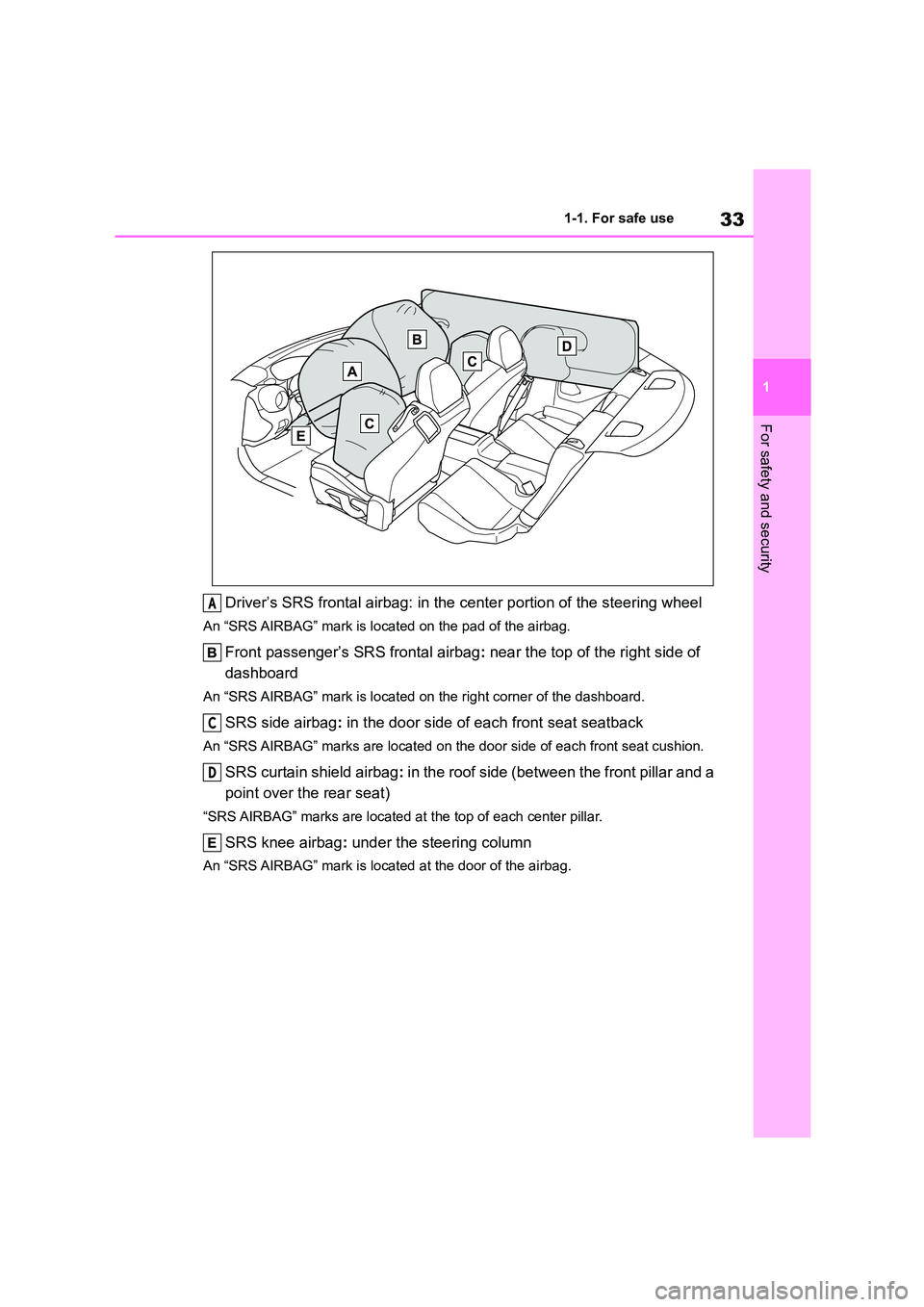
33
1
1-1. For safe use
For safety and security
Driver’s SRS frontal airbag: in the center portion of the steering wheel
An “SRS AIRBAG” mark is located on the pad of the airbag.
Front passenger’s SRS frontal airbag : near the top of the right side of
dashboard
An “SRS AIRBAG” mark is located on the right corner of the dashboard.
SRS side airbag : in the door side of each front seat seatback
An “SRS AIRBAG” marks are located on the door side of each front seat cushion.
SRS curtain shield airbag: in the roof side (between the front pillar and a
point over the rear seat)
“SRS AIRBAG” marks are located at the top of each center pillar.
SRS knee airbag : under the steering column
An “SRS AIRBAG” mark is located at the door of the airbag.
A
C
D
Page 37 of 582

35
1
1-1. For safe use
For safety and security
Side impact sensor (rear wheel house left-hand side)
Side airbag module (driver’s side)
Side impact sensor (cen ter pillar left-hand side)
Seatbelt pretensioner (driver’s side)
Side impact sensor (door left-hand side)
Knee airbag module (driver’s side)
Curtain shield airbag module (left-hand side)
■If the SRS airbag deploys
If the SRS airbag deploys, the fuel sup-
ply will be cut off to reduce the risk of fire caused by leaking fuel. For details about
restarting of the engine, refer to P.335.
■SRS Airbag System Servicing
In the following cases, we recommend that you contact your Toyota dealer as
soon as possible.
●The front part of the vehicle was
involved in an accident in which the
SRS frontal airbags did not deploy.
●The pad of the steering wheel, the
cover over the front passenger’s fron- tal airbag, or either roof side (from the
front pillar to a point over the rear
seat) is scratched, cracked, or other- wise damaged.
●The center pillar, rear wheel house or rear sub frame, or an area near these
parts, was involved in an accident in
which the SRS side airbag and SRS curtain shield airbag did not deploy.
●The fabric or leather of either front seatback is cut, frayed, or otherwise
damaged.
●The rear part of the vehicle was
involved in an accident.
■When you sell your vehicle
When you sell your vehicle, we urge you to inform the buyer that the vehicle is
equipped with SRS airbags. Also, notify
the buyer of the applicable section in this Owner’s Manual.
WA R N I N G
■General Precautions regarding
SRS Airbag System
●To obtain maximum protection in
the event of an accident, the driver
and all passengers must always wear seatbelts when in the vehicle.
The SRS airbags are designed only
to be a supplement to the primary protection provided by the seatbelt.
They do not eliminate the need to
fasten seatbelts. In combination with the seatbelts, they offer the
best combined protection in case of
a serious accident.
Not wearing a seatbelt increases the
chance of severe injury or death in a
crash even when the vehicle has the SRS airbags.
For instructions and precautions con-
cerning the seatbelt system, refer to
P.29.
●The SRS side airbag and SRS cur-
tain shield airbag are designed only to be a supplement to the primary
protection provided by the seatbelt.
They do not eliminate the need to fasten seatbelts. It is also important
to wear your seatbelt to help avoid
injuries that can result when an occupant is not seated in a proper
upright position.
Page 38 of 582
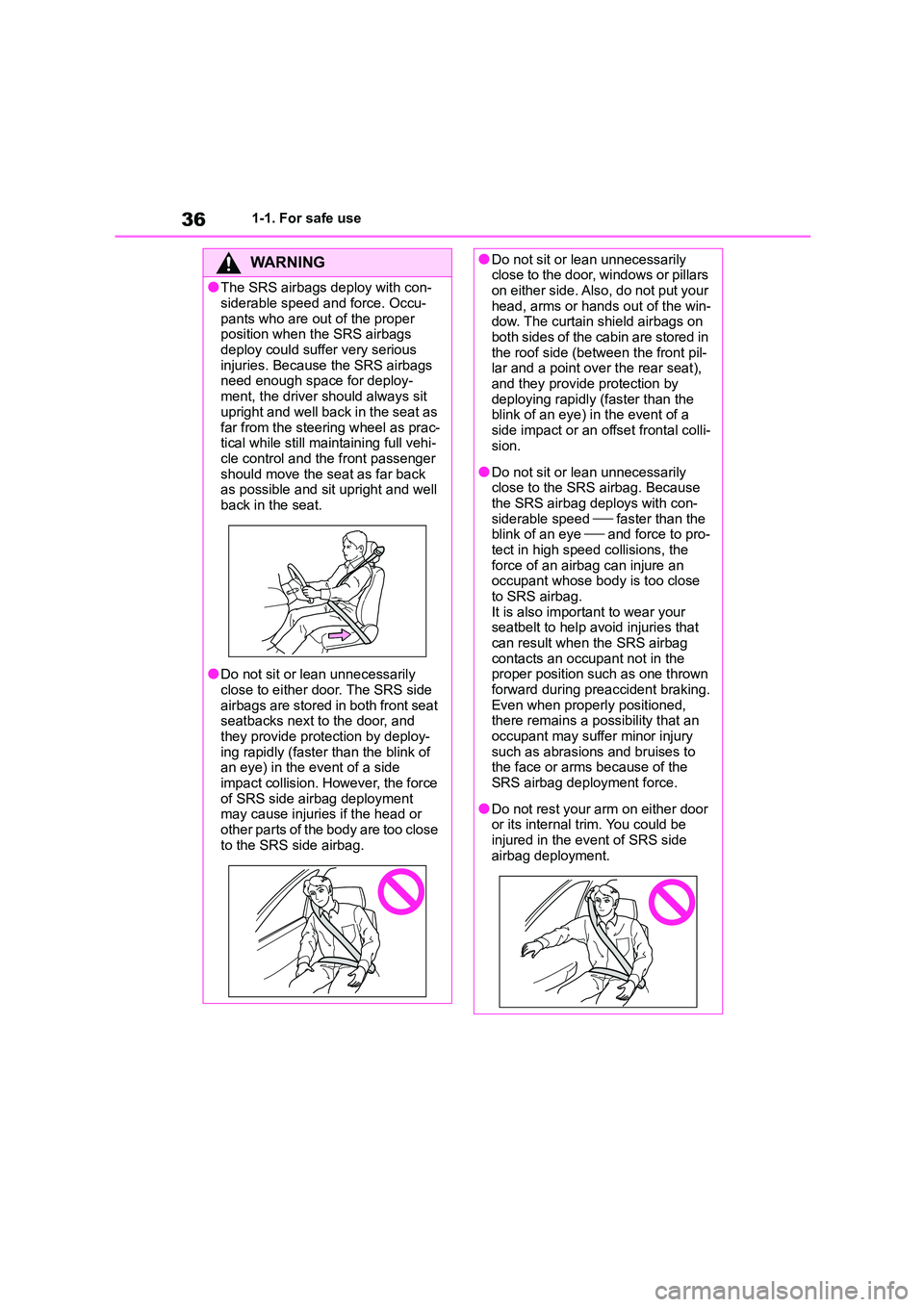
361-1. For safe use
WA R N I N G
●The SRS airbags deploy with con-
siderable speed and force. Occu-
pants who are out of the proper position when the SRS airbags
deploy could suffer very serious
injuries. Because the SRS airbags need enough space for deploy-
ment, the driver should always sit
upright and well back in the seat as
far from the steering wheel as prac- tical while still maintaining full vehi-
cle control and the front passenger
should move the seat as far back as possible and sit upright and well
back in the seat.
●Do not sit or lean unnecessarily
close to either door. The SRS side
airbags are stored in both front seat seatbacks next to the door, and
they provide protection by deploy-
ing rapidly (faster than the blink of an eye) in the event of a side
impact collision. However, the force
of SRS side airbag deployment may cause injuries if the head or
other parts of the body are too close
to the SRS side airbag.
●Do not sit or lean unnecessarily close to the door, windows or pillars
on either side. Also, do not put your
head, arms or hands out of the win- dow. The curtain shield airbags on
both sides of the cabin are stored in
the roof side (between the front pil- lar and a point over the rear seat),
and they provide protection by
deploying rapidly (faster than the blink of an eye) in the event of a
side impact or an offset frontal colli-
sion.
●Do not sit or lean unnecessarily
close to the SRS airbag. Because the SRS airbag deploys with con-
siderable speed faster than the
blink of an eye and force to pro- tect in high speed collisions, the
force of an airbag can injure an
occupant whose body is too close to SRS airbag.
It is also important to wear your
seatbelt to help avoid injuries that can result when the SRS airbag
contacts an occupant not in the
proper position such as one thrown forward during preaccident braking.
Even when properly positioned,
there remains a possibility that an occupant may suffer minor injury
such as abrasions and bruises to
the face or arms because of the SRS airbag deployment force.
●Do not rest your arm on either door or its internal trim. You could be
injured in the event of SRS side
airbag deployment.
Page 43 of 582
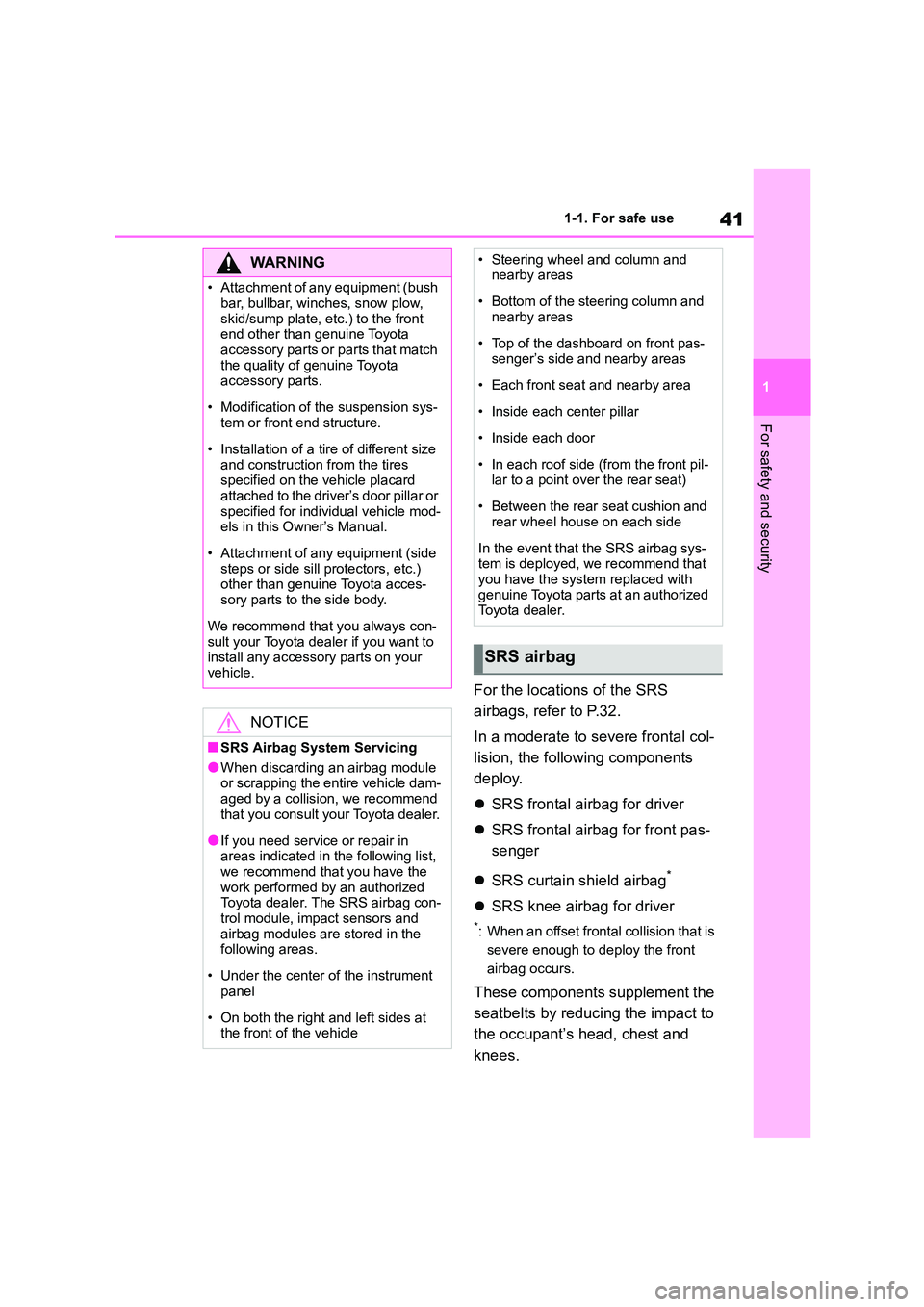
41
1
1-1. For safe use
For safety and security
For the locations of the SRS
airbags, refer to P.32.
In a moderate to severe frontal col-
lision, the following components
deploy.
SRS frontal airbag for driver
SRS frontal airbag for front pas-
senger
SRS curtain shield airbag*
SRS knee airbag for driver
*: When an offset frontal collision that is
severe enough to deploy the front
airbag occurs.
These components supplement the
seatbelts by reducin g the impact to
the occupant’s head, chest and
knees.
WA R N I N G
• Attachment of any equipment (bush
bar, bullbar, winches, snow plow,
skid/sump plate, etc.) to the front end other than genuine Toyota
accessory parts or parts that match
the quality of genuine Toyota accessory parts.
• Modification of the suspension sys-
tem or front end structure.
• Installation of a tire of different size
and construction from the tires specified on the vehicle placard
attached to the driver’s door pillar or
specified for individual vehicle mod- els in this Owner’s Manual.
• Attachment of any equipment (side steps or side sill protectors, etc.)
other than genuine Toyota acces-
sory parts to the side body.
We recommend that you always con-
sult your Toyota dealer if you want to install any accessory parts on your
vehicle.
NOTICE
■SRS Airbag System Servicing
●When discarding an airbag module or scrapping the entire vehicle dam-
aged by a collision, we recommend
that you consult your Toyota dealer.
●If you need service or repair in
areas indicated in the following list, we recommend that you have the
work performed by an authorized
Toyota dealer. The SRS airbag con- trol module, impact sensors and
airbag modules are stored in the
following areas.
• Under the center of the instrument
panel
• On both the right and left sides at
the front of the vehicle
• Steering wheel and column and nearby areas
• Bottom of the steering column and nearby areas
• Top of the dashboard on front pas- senger’s side and nearby areas
• Each front seat and nearby area
• Inside each center pillar
• Inside each door
• In each roof side (from the front pil- lar to a point over the rear seat)
• Between the rear seat cushion and rear wheel house on each side
In the event that the SRS airbag sys- tem is deployed, we recommend that
you have the system replaced with
genuine Toyota parts at an authorized Toyota dealer.
SRS airbag
Page 47 of 582

45
1
1-1. For safe use
For safety and security
frontal impact.
• The vehicle sustains an offset frontal
collision.
• The vehicle strikes an object that can
move or deform, such as a parked
vehicle.
When will the SRS frontal airbag
not deploy?
The driver’s and front passenger’s SRS
frontal airbags are not designed to
deploy in most of the following cases.
• If the vehicle is struck from the side
or from behind
• If the vehicle rolls onto its side or roof
• If the vehicle is involved in a
low-speed frontal collision
In an accident where the vehicle is
impacted more than once, the SRS
frontal airbag deploys only once on
the first impact.
Example: In the case of a double
collision, first with another vehicle,
then against a concrete wall in
immediate succession, once the
SRS frontal airbag is activated on
the first impact, it will not be acti-
Page 53 of 582

51
1
1-1. For safe use
For safety and security• The vehicle rolls onto its side or the
roof.
When is the SRS curtain shield
airbag unlikely to deploy?
There are many types of collisions
which might not necessarily require
SRS curtain shield airbag deployment.
In the event of accidents like those illus-
trated, the SRS curtain shield airbag
may not deploy depending on the level
of accident forces involved.
• The vehicle is involved in an oblique
side-on impact.
• The vehicle is involved in a side-on
impact in an area outside the vicinity
of the passenger compartment.
• The vehicle strikes a telephone pole
or similar object.
• The vehicle is involved in a side-on
impact from a motorcycle.
• The vehicle rolls onto its side or the
roof.
Page 61 of 582

59
1
1-2. Child safety
For safety and security
WA R N I N G
WA R N I N G
●Do not allow the child to lean
his/her head or any part of his/her body against the door or the area of
the seat, front or rear pillars, or roof
side rails from which the SRS side airbags or SRS curtain shield
airbags deploy even if the child is
seated in the child restraint system. It is dangerous if the SRS side
airbags and curtain shield airbags
inflate, and the impact could cause death or serious injury to the child.
●When a junior seat is installed,
always ensure that the shoulder belt is positioned across the center
of the child’s shoulder. The belt
should be kept away from the
child’s neck, but not so that it could fall off the child’s shoulder.
●Use child restrain t system suitable to the age and size of the child and
install it to the rear seat.
Page 263 of 582
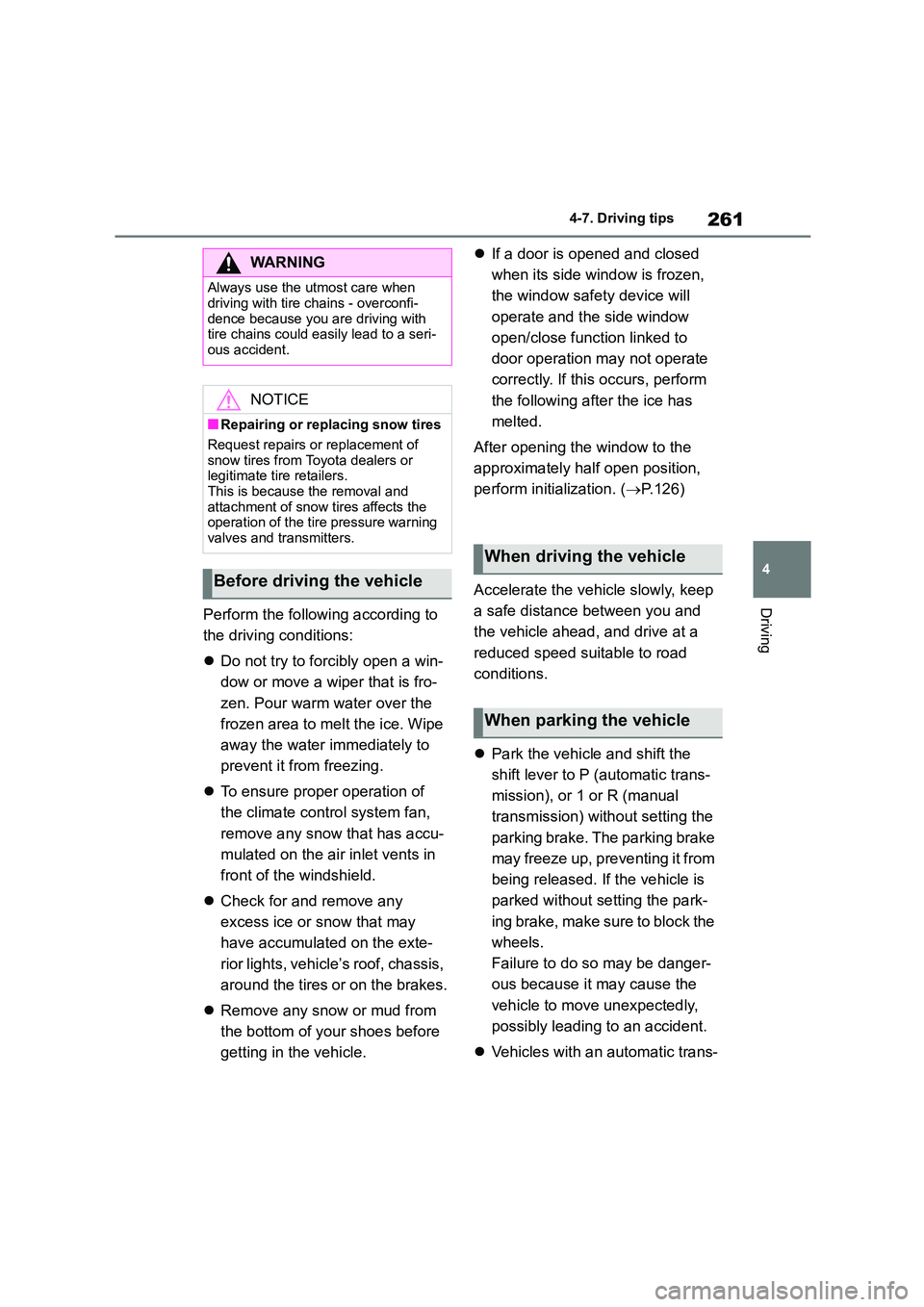
261
4
4-7. Driving tips
DrivingPerform the following according to
the driving conditions:
Do not try to forcibly open a win-
dow or move a wiper that is fro-
zen. Pour warm water over the
frozen area to melt the ice. Wipe
away the water immediately to
prevent it from freezing.
To ensure proper operation of
the climate control system fan,
remove any snow that has accu-
mulated on the air inlet vents in
front of the windshield.
Check for and remove any
excess ice or snow that may
have accumulated on the exte-
rior lights, vehicle’s roof, chassis,
around the tires or on the brakes.
Remove any snow or mud from
the bottom of your shoes before
getting in the vehicle.
If a door is opened and closed
when its side window is frozen,
the window safety device will
operate and the side window
open/close function linked to
door operation may not operate
correctly. If this occurs, perform
the following after the ice has
melted.
After opening the window to the
approximately half open position,
perform initialization. ( P.126)
Accelerate the vehicle slowly, keep
a safe distance between you and
the vehicle ahead, and drive at a
reduced speed suitable to road
conditions.
Park the vehicle and shift the
shift lever to P (automatic trans-
mission), or 1 or R (manual
transmission) with out setting the
parking brake. The parking brake
may freeze up, preventing it from
being released. If the vehicle is
parked without setting the park-
ing brake, make sure to block the
wheels.
Failure to do so may be danger-
ous because it may cause the
vehicle to move unexpectedly,
possibly leading to an accident.
Vehicles with an automatic trans-
WA R N I N G
Always use the utmost care when
driving with tire chains - overconfi-
dence because you are driving with tire chains could easily lead to a seri-
ous accident.
NOTICE
■Repairing or replacing snow tires
Request repairs or replacement of snow tires from Toyota dealers or
legitimate tire retailers.
This is because the removal and attachment of snow tires affects the
operation of the tire pressure warning
valves and transmitters.
Before driving the vehicle
When driving the vehicle
When parking the vehicle
Page 284 of 582
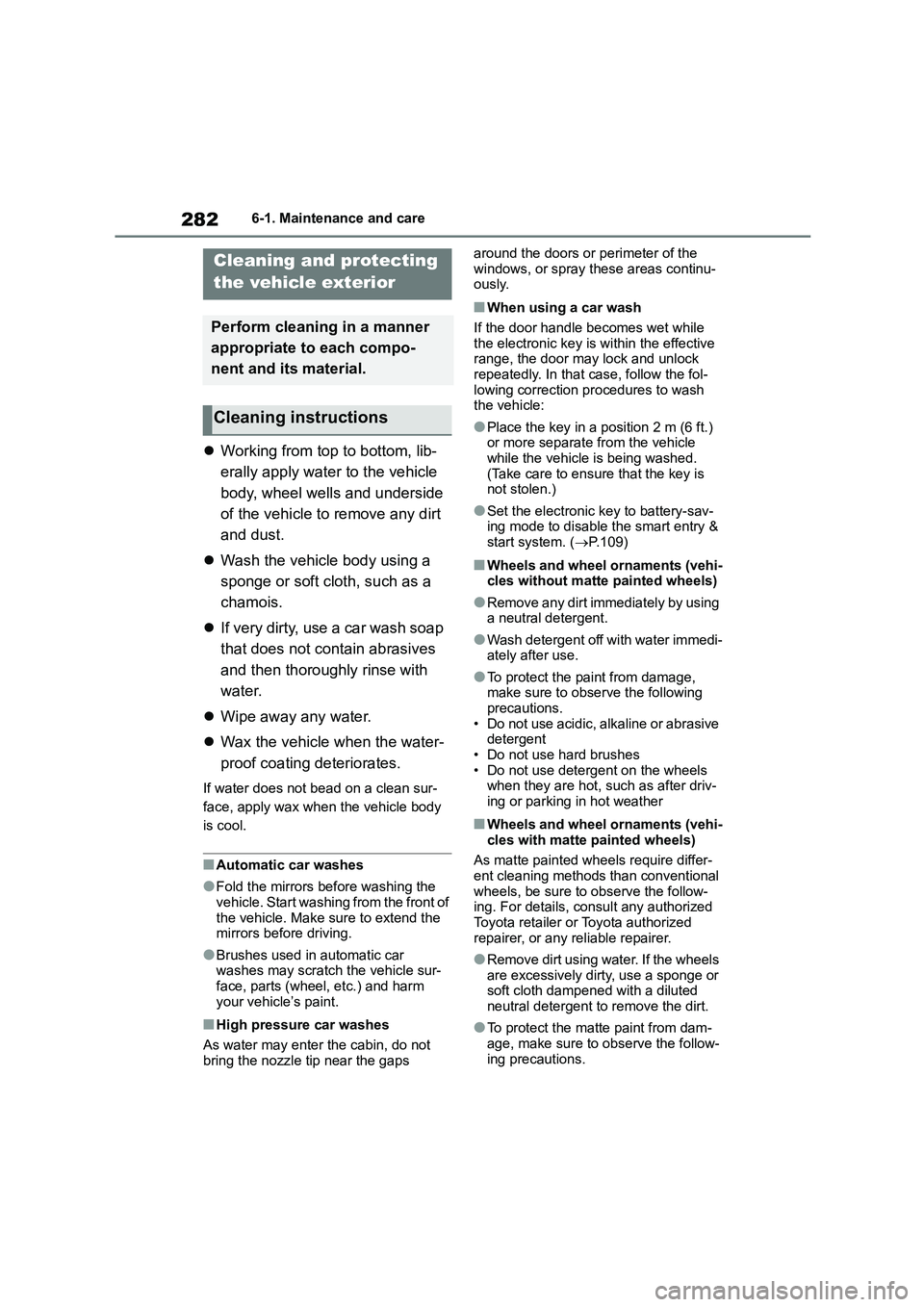
2826-1. Maintenance and care
6-1.Maintenance and care
Working from top to bottom, lib-
erally apply water to the vehicle
body, wheel wells and underside
of the vehicle to remove any dirt
and dust.
Wash the vehicle body using a
sponge or soft cloth, such as a
chamois.
If very dirty, use a car wash soap
that does not contain abrasives
and then thoroughly rinse with
water.
Wipe away any water.
Wax the vehicle when the water-
proof coating deteriorates.
If water does not bead on a clean sur-
face, apply wax when the vehicle body
is cool.
■Automatic car washes
●Fold the mirrors before washing the
vehicle. Start washing from the front of
the vehicle. Make sure to extend the mirrors before driving.
●Brushes used in automatic car washes may scratch the vehicle sur-
face, parts (wheel, etc.) and harm
your vehicle’s paint.
■High pressure car washes
As water may enter the cabin, do not
bring the nozzle tip near the gaps
around the doors or perimeter of the
windows, or spray these areas continu- ously.
■When using a car wash
If the door handle becomes wet while
the electronic key is within the effective range, the door may lock and unlock
repeatedly. In that case, follow the fol-
lowing correction procedures to wash the vehicle:
●Place the key in a position 2 m (6 ft.) or more separate from the vehicle
while the vehicle is being washed.
(Take care to ensure that the key is not stolen.)
●Set the electronic key to battery-sav-ing mode to disable the smart entry &
start system. ( P.109)
■Wheels and wheel ornaments (vehi-
cles without matte painted wheels)
●Remove any dirt immediately by using
a neutral detergent.
●Wash detergent off with water immedi-
ately after use.
●To protect the paint from damage,
make sure to observe the following precautions.
• Do not use acidic, alkaline or abrasive
detergent • Do not use hard brushes
• Do not use detergent on the wheels
when they are hot, such as after driv- ing or parking in hot weather
■Wheels and wheel ornaments (vehi-
cles with matte painted wheels)
As matte painted wheels require differ- ent cleaning methods than conventional
wheels, be sure to observe the follow-
ing. For details, consult any authorized
Toyota retailer or Toyota authorized repairer, or any reliable repairer.
●Remove dirt using water. If the wheels are excessively dirty, use a sponge or
soft cloth dampened with a diluted
neutral detergent to remove the dirt.
●To protect the matte paint from dam-
age, make sure to observe the follow- ing precautions.
Cleaning and protecting
the vehicle exterior
Perform cleaning in a manner
appropriate to each compo-
nent and its material.
Cleaning instructions
Page 355 of 582
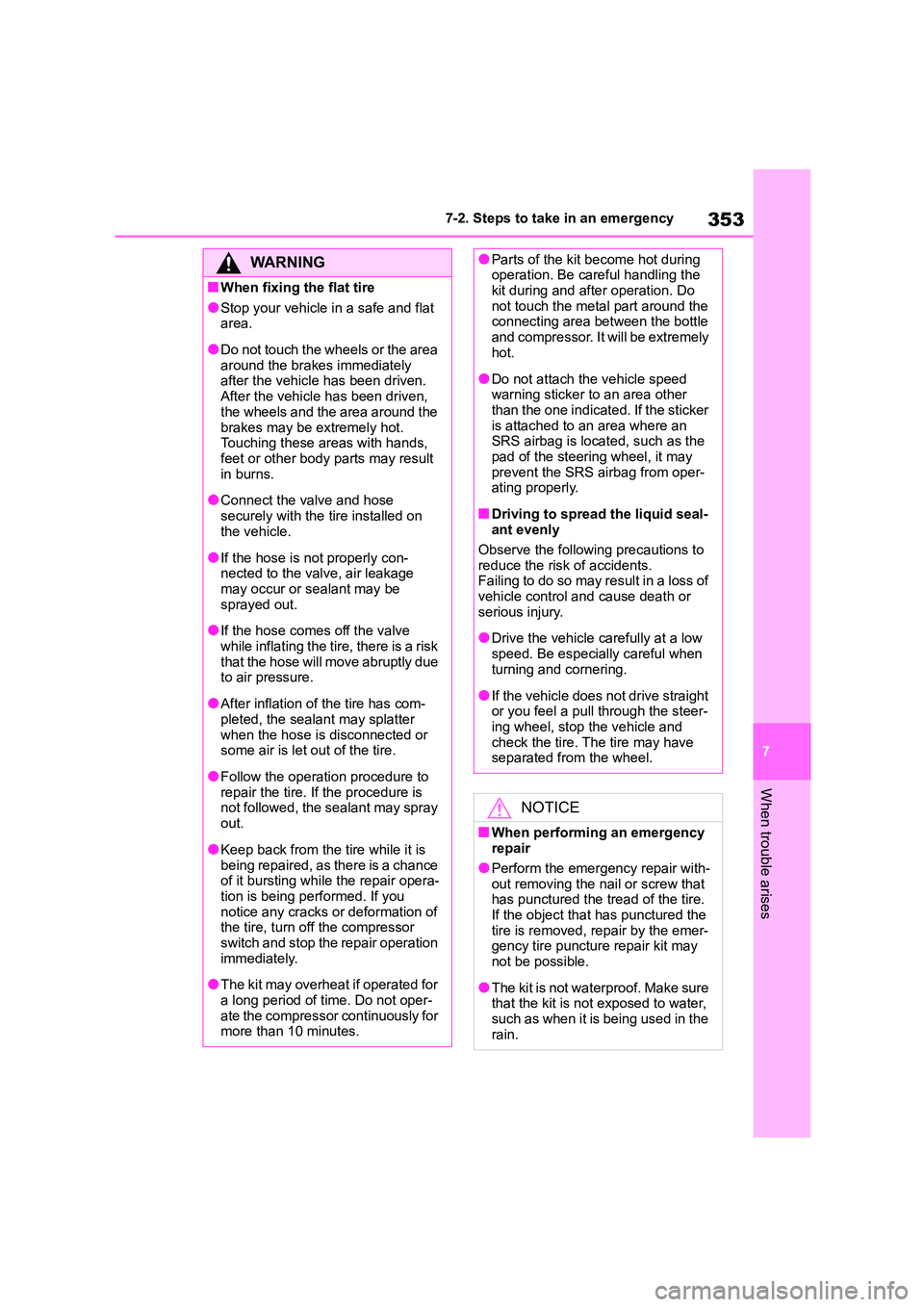
353
7
7-2. Steps to take in an emergency
When trouble arises
WA R N I N G
■When fixing the flat tire
●Stop your vehicle in a safe and flat
area.
●Do not touch the wheels or the area
around the brakes immediately after the vehicle has been driven.
After the vehicle has been driven,
the wheels and the area around the
brakes may be extremely hot. Touching these areas with hands,
feet or other body parts may result
in burns.
●Connect the valve and hose
securely with the tire installed on the vehicle.
●If the hose is not properly con-nected to the valve, air leakage
may occur or sealant may be
sprayed out.
●If the hose comes off the valve
while inflating the tire, there is a risk that the hose will move abruptly due
to air pressure.
●After inflation of the tire has com-
pleted, the sealant may splatter
when the hose is disconnected or some air is let out of the tire.
●Follow the operation procedure to repair the tire. If the procedure is
not followed, the sealant may spray
out.
●Keep back from the tire while it is
being repaired, as there is a chance of it bursting while the repair opera-
tion is being performed. If you
notice any cracks or deformation of the tire, turn off the compressor
switch and stop the repair operation
immediately.
●The kit may overheat if operated for
a long period of time. Do not oper- ate the compressor continuously for
more than 10 minutes.
●Parts of the kit become hot during operation. Be careful handling the
kit during and after operation. Do
not touch the metal part around the connecting area between the bottle
and compressor. It will be extremely
hot.
●Do not attach the vehicle speed
warning sticker to an area other than the one indicated. If the sticker
is attached to an area where an
SRS airbag is located, such as the pad of the steering wheel, it may
prevent the SRS airbag from oper-
ating properly.
■Driving to spread the liquid seal-
ant evenly
Observe the following precautions to
reduce the risk of accidents.
Failing to do so may result in a loss of vehicle control and cause death or
serious injury.
●Drive the vehicle carefully at a low
speed. Be especially careful when
turning and cornering.
●If the vehicle does not drive straight
or you feel a pull through the steer- ing wheel, stop the vehicle and
check the tire. The tire may have
separated from the wheel.
NOTICE
■When performing an emergency repair
●Perform the emergency repair with-
out removing the nail or screw that has punctured the tread of the tire.
If the object that has punctured the
tire is removed, repair by the emer- gency tire puncture repair kit may
not be possible.
●The kit is not waterproof. Make sure
that the kit is not exposed to water,
such as when it is being used in the rain.